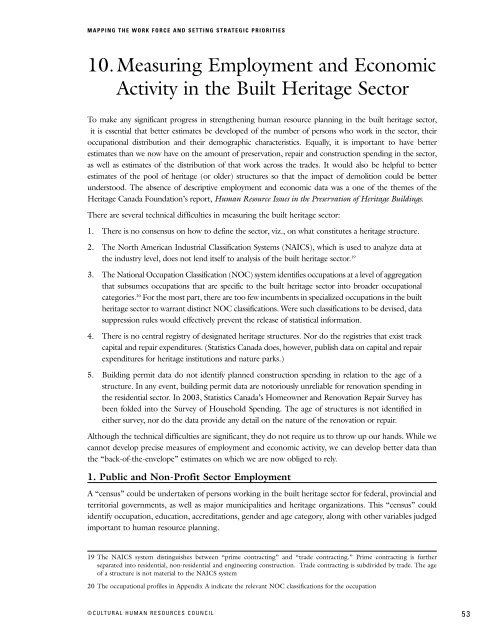Human Resources in Canada's Built Heritage Sector: Mapping the ...
Human Resources in Canada's Built Heritage Sector: Mapping the ...
Human Resources in Canada's Built Heritage Sector: Mapping the ...
- No tags were found...
Create successful ePaper yourself
Turn your PDF publications into a flip-book with our unique Google optimized e-Paper software.
MAPPING THE WORK FORCE AND SETTING STRATEGIC PRIORITIES10. Measur<strong>in</strong>g Employment and EconomicActivity <strong>in</strong> <strong>the</strong> <strong>Built</strong> <strong>Heritage</strong> <strong>Sector</strong>To make any significant progress <strong>in</strong> streng<strong>the</strong>n<strong>in</strong>g human resource plann<strong>in</strong>g <strong>in</strong> <strong>the</strong> built heritage sector,it is essential that better estimates be developed of <strong>the</strong> number of persons who work <strong>in</strong> <strong>the</strong> sector, <strong>the</strong>iroccupational distribution and <strong>the</strong>ir demographic characteristics. Equally, it is important to have betterestimates than we now have on <strong>the</strong> amount of preservation, repair and construction spend<strong>in</strong>g <strong>in</strong> <strong>the</strong> sector,as well as estimates of <strong>the</strong> distribution of that work across <strong>the</strong> trades. It would also be helpful to betterestimates of <strong>the</strong> pool of heritage (or older) structures so that <strong>the</strong> impact of demolition could be betterunderstood. The absence of descriptive employment and economic data was a one of <strong>the</strong> <strong>the</strong>mes of <strong>the</strong><strong>Heritage</strong> Canada Foundation’s report, <strong>Human</strong> Resource Issues <strong>in</strong> <strong>the</strong> Preservation of <strong>Heritage</strong> Build<strong>in</strong>gs.There are several technical difficulties <strong>in</strong> measur<strong>in</strong>g <strong>the</strong> built heritage sector:1. There is no consensus on how to def<strong>in</strong>e <strong>the</strong> sector, viz., on what constitutes a heritage structure.2. The North American Industrial Classification Systems (NAICS), which is used to analyze data at<strong>the</strong> <strong>in</strong>dustry level, does not lend itself to analysis of <strong>the</strong> built heritage sector. 193. The National Occupation Classification (NOC) system identifies occupations at a level of aggregationthat subsumes occupations that are specific to <strong>the</strong> built heritage sector <strong>in</strong>to broader occupationalcategories. 20 For <strong>the</strong> most part, <strong>the</strong>re are too few <strong>in</strong>cumbents <strong>in</strong> specialized occupations <strong>in</strong> <strong>the</strong> buil<strong>the</strong>ritage sector to warrant dist<strong>in</strong>ct NOC classifications. Were such classifications to be devised, datasuppression rules would effectively prevent <strong>the</strong> release of statistical <strong>in</strong>formation.4. There is no central registry of designated heritage structures. Nor do <strong>the</strong> registries that exist trackcapital and repair expenditures. (Statistics Canada does, however, publish data on capital and repairexpenditures for heritage <strong>in</strong>stitutions and nature parks.)5. Build<strong>in</strong>g permit data do not identify planned construction spend<strong>in</strong>g <strong>in</strong> relation to <strong>the</strong> age of astructure. In any event, build<strong>in</strong>g permit data are notoriously unreliable for renovation spend<strong>in</strong>g <strong>in</strong><strong>the</strong> residential sector. In 2003, Statistics Canada’s Homeowner and Renovation Repair Survey hasbeen folded <strong>in</strong>to <strong>the</strong> Survey of Household Spend<strong>in</strong>g. The age of structures is not identified <strong>in</strong>ei<strong>the</strong>r survey, nor do <strong>the</strong> data provide any detail on <strong>the</strong> nature of <strong>the</strong> renovation or repair.Although <strong>the</strong> technical difficulties are significant, <strong>the</strong>y do not require us to throw up our hands. While wecannot develop precise measures of employment and economic activity, we can develop better data than<strong>the</strong> “back-of-<strong>the</strong>-envelope” estimates on which we are now obliged to rely.1. Public and Non-Profit <strong>Sector</strong> EmploymentA “census” could be undertaken of persons work<strong>in</strong>g <strong>in</strong> <strong>the</strong> built heritage sector for federal, prov<strong>in</strong>cial andterritorial governments, as well as major municipalities and heritage organizations. This “census” couldidentify occupation, education, accreditations, gender and age category, along with o<strong>the</strong>r variables judgedimportant to human resource plann<strong>in</strong>g.19 The NAICS system dist<strong>in</strong>guishes between “prime contract<strong>in</strong>g” and “trade contract<strong>in</strong>g.” Prime contract<strong>in</strong>g is fur<strong>the</strong>rseparated <strong>in</strong>to residential, non-residential and eng<strong>in</strong>eer<strong>in</strong>g construction. Trade contract<strong>in</strong>g is subdivided by trade. The ageof a structure is not material to <strong>the</strong> NAICS system20 The occupational profiles <strong>in</strong> Appendix A <strong>in</strong>dicate <strong>the</strong> relevant NOC classifications for <strong>the</strong> occupation©CULTURAL HUMAN RESOURCES COUNCIL53










